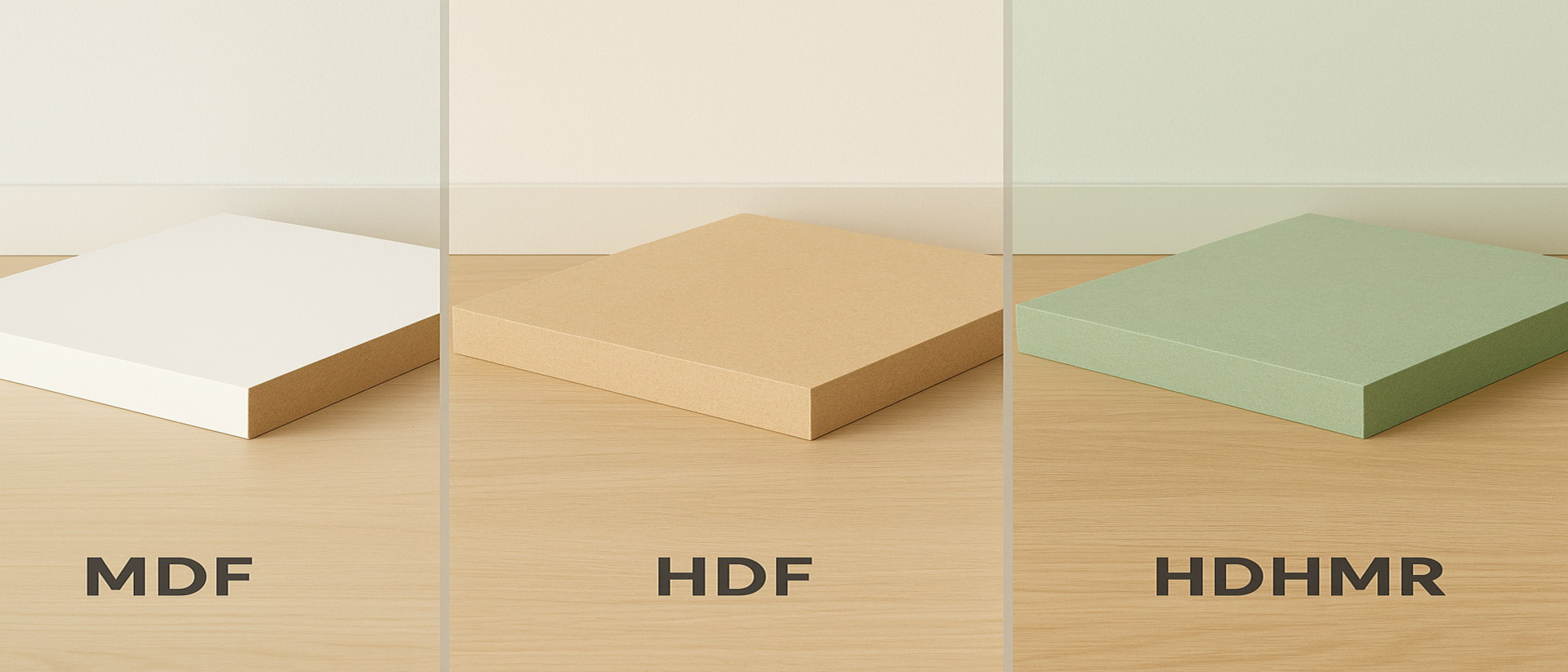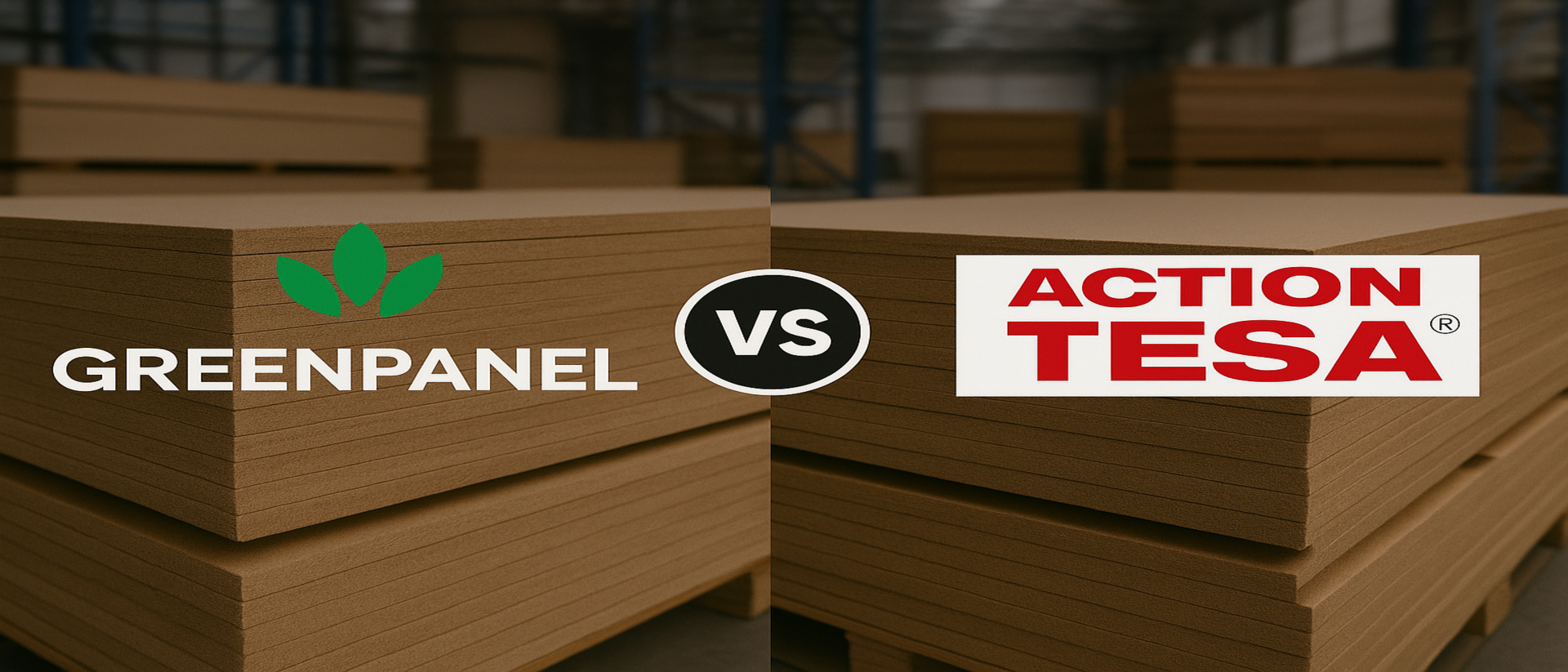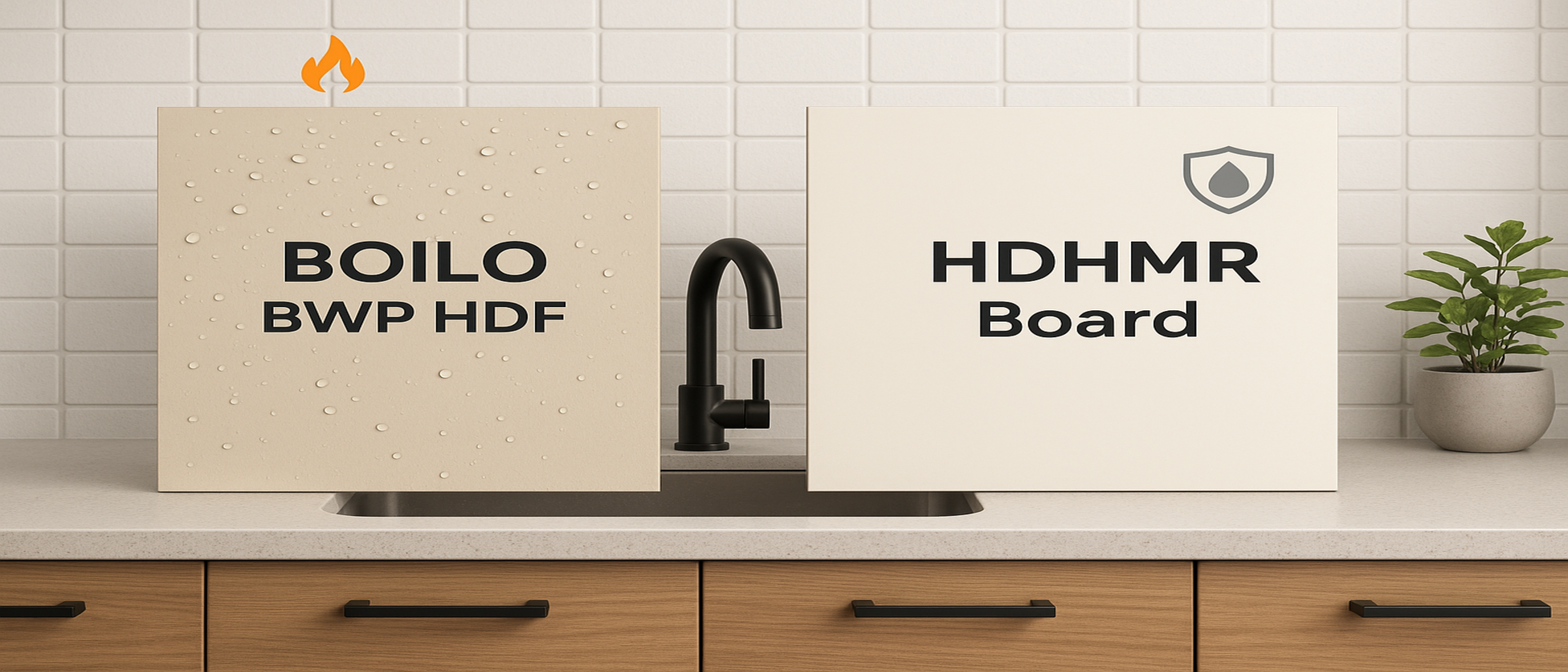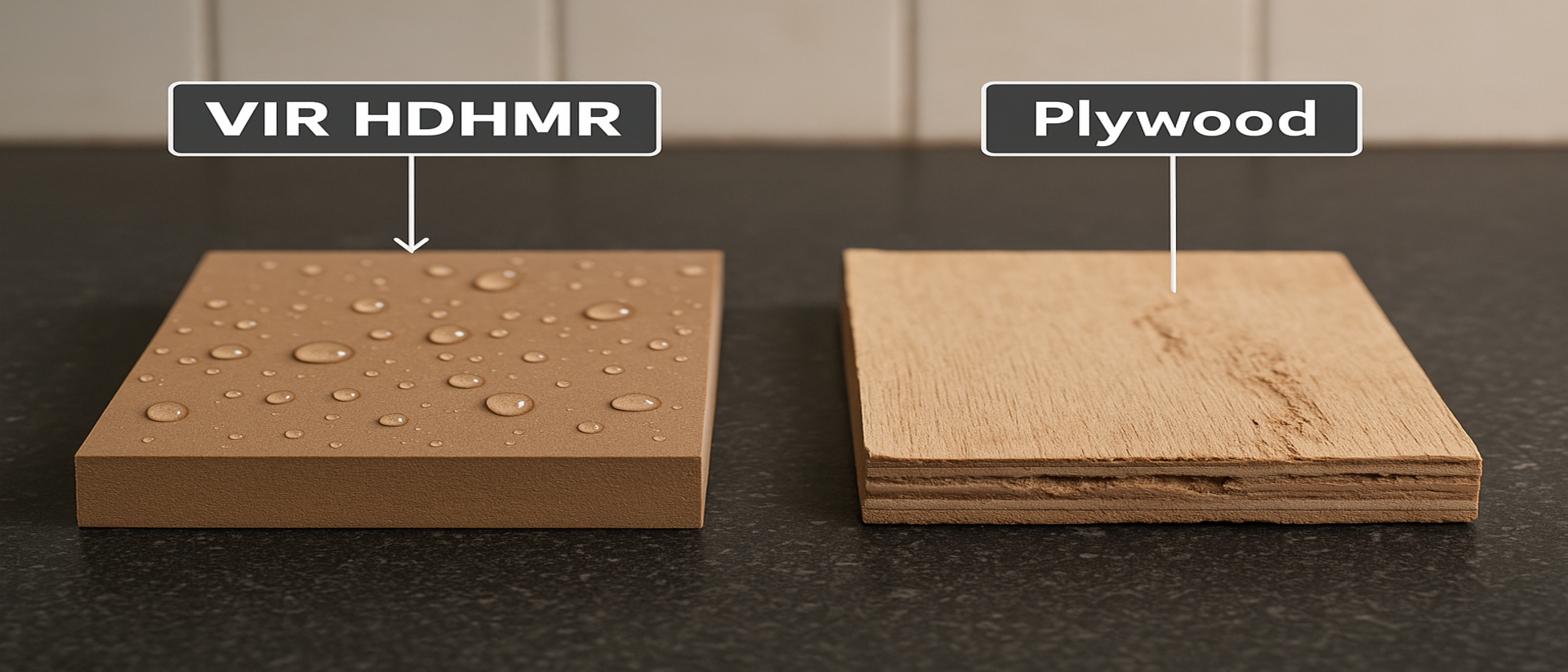Introduction
Engineered wood panels range from basic (MDF) to premium (HDHMR). MDF (Medium Density Fiberboard) is an economical, smooth board made of wood fibers and resin. HDF (High Density Fiberboard) is similar but denser and stronger. HDHMR (High Density High Moisture Resistant) is a top-tier HDF with special resin for water resistance. This comparison breaks down their 2025 specs, strengths, and costs. Knowing these differences helps select the right material for each project: e.g., MDF for indoor trims, HDF for heavy-duty use, and HDHMR for moist environments.
2025 Technical Specs & Price Comparison
· Density: MDF has medium density (~600–700 kg/m³). HDF is denser (~800–900 kg/m³). HDHMR is in the same density range as HDF (around 800–900 kg/m³) but is manufactured with higher compaction. All three are heavier than plywood of the same thickness.
· Strength: HDF and HDHMR are significantly stronger than MDF. HDF is made under higher pressure, making it suited for heavy loads. HDHMR, though essentially HDF in composition, usually has even greater rigidity due to its resin formula. MDF is soft and can flex under weight.
· Moisture Resistance: Standard MDF absorbs moisture easily. HDF is somewhat more water-tolerant but still swells when wet. HDHMR is explicitly formulated to resist moisture: it uses melamine-urea resin and wax to stay stable in humid environments. In simple terms: MDF < HDF < HDHMR in water resistance.
· Workability: All three cut and shape like wood, but MDF cuts the cleanest (very smooth surface). HDF and HDHMR require sharp tools (they dull blades faster). HDHMR edges are less prone to chipping because of its dense finish.
· Price (2025): MDF is the cheapest – around ₹35–50/sqft for 12mm sheets. HDF costs more (roughly ₹50–80/sqft), as it undergoes more pressing. HDHMR is the most expensive (₹80–120/sqft) due to added moisture protection. All prices vary by brand and thickness, but the rank is consistent: MDF < HDF < HDHMR.
Strengths & Weaknesses of Each Material
MDF (Medium Density Fiberboard)
· Strengths: MDF is affordable and has a very smooth surface, perfect for laminating or painting. It cuts and routs with little grain, so edges are clean. For light indoor use – wall panels, decorative trims, or low-load furniture – MDF is adequate.
· Weaknesses: It has moderate strength only. Long spans (like large shelves) will sag if unsupported. MDF has poor moisture resistance: even humidity can cause swelling at edges. It holds screws less well than HDF/HDHMR (especially at edges, which can split if over-tightened). Termite resistance is low. In wet or heavy-use areas, MDF fails quickly.
HDF (High Density Fiberboard)
· Strengths: HDF is simply MDF pressed harder. It is harder and more durable than MDF, making it suitable for high-traffic surfaces (flooring backing, tougher furniture). It supports weight and wear better. Its smooth surface still accepts laminates/veneers nicely. Compared to MDF, HDF shows less sagging under load and better screw retention.
· Weaknesses: HDF costs more than MDF. It still absorbs water (it’s not specifically moisture-proof), so it won’t last long in kitchens or bathrooms without sealing. It can be nearly as hard as HDHMR (depending on grade), but lacks the engineered moisture stability.
HDHMR (High Density High Moisture Resistant)
· Strengths: HDHMR is the highest-performance of the three. It combines HDF’s density with water-resistant resin. Thus it resists moisture and impact better than HDF. It is very stiff, good for heavy cabinets and long shelves. Its homogeneous core means edges won’t chip easily. In a damp kitchen or bathroom, HDHMR stands up where MDF/HDF would warp.
· Weaknesses: HDHMR is the most expensive. It is also very heavy and hard on tools (blades dull quickly). If overbent, HDHMR can crack rather than flex. Also, being highly dense, it can be more brittle than normal plywood in some cases. But overall, it far outperforms the other two if moisture or strength is a priority.
Durability & Moisture Resistance
In dry indoor conditions, all three can last years, but use context changes things. MDF and HDF are vulnerable to moisture: even high-quality HDF will swell and lose strength if exposed to water. HDHMR, however, is treated to withstand humidity. For durability: HDHMR > HDF >> MDF. A summary from industry notes: “HDHMR exceeds both [MDF and HDF] in terms of durability and moisture resistance”. For example, HDHMR kitchen cabinets won’t warp when MDF shelves in a similar setup would. Thus, in areas with any moisture or heavy wear (lockers, moisture-prone office furniture), HDHMR is recommended. In dry, gentle-use settings (interior paneling, speaker boxes, IKEA-style furniture), MDF/HDF may suffice and save cost.
Applications / Best Use Cases
· MDF: Best for budget, decorative, or light-use projects. Ideal for painted furniture, wall paneling, and craft projects. Also used for drawer bottoms, speaker boxes, and decorative moldings. Avoid MDF in kitchens or outdoors.
· HDF: Good for high-traffic interiors. Use HDF for laminate flooring (as a core under laminate tiles), tough shelves in offices, or high-use furniture that stays dry. It bridges the gap when you need more strength than MDF but don’t require full HDHMR.
· HDHMR: Perfect for wet or heavy-duty areas. Use HDHMR in kitchens, bathrooms, wardrobes (especially in humid climates), commercial furniture, and anywhere you would otherwise use plywood with high moisture grade. Also for outdoor-tolerant interiors like sunrooms (with proper sealing). Essentially, choose HDHMR wherever moisture resistance and robustness are required.
Cost Analysis & Value for Money
MDF is the cheapest upfront choice. However, “you get what you pay for.” MDF’s low cost comes with low lifespan in many uses. HDF doubles the cost with noticeable improvement in rigidity. HDHMR, while roughly 2–3× the price of MDF, can replace plywood in many uses and avoid future replacement costs. A leading panel maker notes MDF is ₹35–50/sqft, HDF ₹50–80, and HDHMR ₹80–120. When estimating value, consider durability: an HDHMR cabinet may last decades in a wet kitchen, whereas MDF might fail in a few years. Thus HDHMR often gives the best long-term value for moisture-prone, high-end projects, despite its higher initial outlay.
Buyer’s Checklist: Which to Choose?
· Moisture Concern: For any moisture contact (kitchens, baths), HDHMR is the safe pick. HDF or MDF should be strictly for dry areas.
· Load & Wear: For heavy loads (long spans, heavy equipment), prefer HDHMR. HDF can handle moderate loads (like laminate flooring or mid-range furniture). MDF is only for light loads.
· Budget: MDF fits tight budgets but plan replacements sooner. HDF is mid-tier. HDHMR is premium. Determine if performance needs justify cost.
· Finish Quality: MDF’s ultra-smooth surface is easiest to paint or veneer. If finish is top priority and moisture is not a factor, MDF is fine. HDHMR also sands smooth but costs more.
· Workability: All cut well, but remember HDF/HDHMR dull blades faster. If frequent re-screwing or modifications are expected, HDHMR’s strength is forgiving.
· Longevity: For long-term installations (20+ years), HDHMR is best. HDF also lasts long if kept dry. Expect MDF to start degrading in a decade under normal indoor conditions.
FAQs
Q1: How does HDF differ from MDF?
HDF is simply a higher-density version of MDF. It’s pressed at higher pressure so it’s harder and stronger. In effect, HDF is more rigid and has better load capacity than MDF, but requires more powerful pressing equipment to make. The raw materials (wood fibers and resin) are similar, just more compressed.
Q2: Is HDHMR the same as HDF?
HDHMR is a form of HDF that is specifically designed for high moisture resistance. In manufacturing, HDHMR boards use a water-resistant resin (like melamine-urea-formaldehyde) plus wax additives. So while all HDHMR is HDF by density, not all HDF qualifies as HDHMR. If a manufacturer labels a board HDHMR (or HDF-HMR/HDFWR), expect superior water stability.
Q3: Which board is best for laminate flooring?
HDF is commonly used under laminate flooring because of its rigidity. MDF would be too soft (it would dent). HDHMR is even stronger than needed for flooring and costs more – HDF is the usual choice. For truly water-proof floors, WPC boards are another option, but among wood fiber boards, HDF is the ideal balance of strength and cost.
Q4: Can I use MDF in a kitchen or bathroom?
Regular MDF is not recommended for kitchens or bathrooms. It will absorb moisture and swell. If you need fiberboard in a wet area, use HDHMR. MDF should be limited to dry indoor projects (bedroom furniture, closets, decorative panels).
Q5: Are there formaldehyde concerns with these boards?
Standard MDF/HDF often use urea-formaldehyde resin, which can emit VOCs. Many HDHMR boards use advanced MUF (Melamine UF) resin that is more water-resistant and often lower-emitting. Look for E1/E0-rated boards if low emissions are required. All large manufacturers now sell low-formaldehyde or no-added-formaldehyde grades for indoor use.
Q6: Which board is most cost-effective?
For sheer cost, MDF is cheapest upfront. But for functional cost-effectiveness, match the board to use: using HDHMR in a kitchen avoids replacement costs. Many experts advise that HDHMR’s higher price is offset by its “long-term performance and low maintenance”. So, MDF saves money now, HDHMR saves money later. HDF sits in the middle.
Conclusion
In summary, MDF, HDF, and HDHMR serve a progression of needs. MDF boards are budget-friendly and fine for dry, decorative uses. HDF offers extra strength for heavy-use interiors. HDHMR adds moisture protection on top of HDF’s strength, making it ideal for kitchens, bathrooms, and outdoor-sheltered areas. Choosing the right board depends on environment, load, and finish: MDF for cost-sensitive dry projects; HDF for tough loads; HDHMR when water resistance is crucial. Understanding these differences ensures you pick a board that balances performance and price. To explore options or get a quote for HDHMR boards, contact us – we’ll guide you to the best choice for your project.
Disclaimer: This article is generated using AI-assisted research and is intended for informational purposes only. While we strive for accuracy, readers are advised to verify all technical, pricing, and brand-specific details with official sources. hdhmr.in is not liable for any decisions made based on this content.




